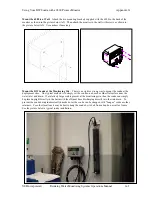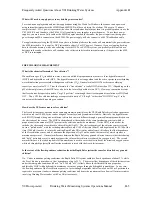
Frequently Asked Questions About YSI Drinking Water Systems
Appendix H
YSI Incorporated Drinking Water Monitoring Systems Operations Manual
H-9
How often should I check the accuracy of and/or recalibrate the free chlorine sensor?
You should confirm the accuracy of your free chlorine readings relative to a DPD colorimetric analysis within one
week of your deployment and as often as possible thereafter. Calibration checks involve making a visit to the
deployment site, performing a DPD colorimetric test of the flow cell effluent with a handheld, battery-powered
colorimeter and recalibrating the sensor if significant drift is evident. It is important to note that because the free
chlorine sensor is calibrated
in situ
, i.e., in flowing water in the flow cell, the sonde setup at the site need not be
disturbed, making the recalibration procedure very quick and easy. If drift in the same direction continues to be
observed, if calibration errors are evident during the calibration process, and/or if the free chlorine readings become
jumpy, then you should remove the free chlorine probe from the sonde, recondition it, install a new membrane, and
activate the sensor as described in Section 2.6.1 of the Drinking Water Sonde Manual.
How accurate is the colorimetric DPD check of accuracy?
Commercial colorimeters for DPD analysis are very accurate when used properly. However, there can be errors in the
determination which result either from user technique or water chemistry. For example, there can be errors in the DPD
determination which are caused by dirty cells during the analysis processes of zeroing the instrument or taking a
reading. In addition, reagents which are out of date and thus have lost their potency could cause errors. To avoid
problems of this nature, always make sure that the colorimeter cell has been wiped clean with lens cleaning paper both
prior to taking the zero reading and after addition of reagent prior to taking an actual reading. Also make certain that
the reagent pills or packets are within their shelf-life limitation. Since the analysis is so easy to perform, you should
always perform repetitive analyses of the flow cell effluent until subsequent readings agree within the specification of
the colorimeter – typically 0.05 mg/L.
The DPD analytical procedure for free chlorine is also susceptible to interferences from any oxidizing species other
than free chlorine in the water which might oxidize the DPD reagent. If these non-chlorine oxidizing species are
present, then they will produce color in addition to that from the free chlorine and this will result in a DPD chlorine
value which is erroneously high. Fortunately, the rate of color formation is usually relatively slow compared to that
from free chlorine which is effectively instantaneous. Therefore, you can usually determine if extraneous oxidizing
species are present in the water sample by reading the color immediately after reagent addition and then again after
about 2 minutes. If the value does not change significantly, then the color is likely to be due to free chlorine only; if
the reading after 2 minutes is significantly different, then it is likely that other color-forming oxidants are present and
the free chlorine reading could be in error.
Содержание 600DW-B
Страница 3: ......
Страница 239: ...Principles of Operation Section 5 YSI Incorporated Drinking Water Monitoring Systems Operation Manual 5 26...
Страница 251: ...Warranty and Service Information Section 8 YSI Incorporated Drinking Water Monitoring Systems Operations Manual 8 4...
Страница 259: ...Required Notice Appendix B YSI Incorporated Drinking Water Monitoring Systems Operations Manual B 2...
Страница 264: ...EMC Performance Appendix D YSI Incorporated Drinking Water Monitoring Systems Operations Manual D 2...
Страница 268: ...Specifications Appendix E YSI Incorporated Drinking Water Monitoring Systems Operations Manual E 4...
Страница 297: ......




































